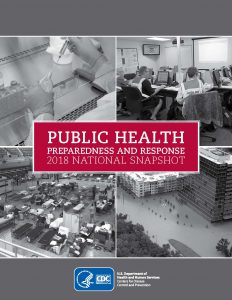Moving the Dial on Preparedness: CDC’s 2018 National Snapshot
Posted on by
Every year, CDC’s Office of Public Health Preparedness and Response publishes the Public Health Preparedness and Response National Snapshot, an annual report that highlights the work of CDC and our partners. No matter the type, size, or cause of a public health emergency, we must work together to respond to the best of our ability.

The Snapshot includes two sections:
- The Narrative describes CDC preparedness and response activities in 2016 and 2017 and demonstrates how investments in preparedness enhance the nation’s ability to respond to public health threats and emergencies.
- The Public Health Emergency Preparedness (PHEP) Program Fact sheets provide information on PHEP funding from 2015 to 2017 and trends and progress related to the 15 public health preparedness capabilities defined in the PHEP Cooperative Agreement. They also feature a short story that demonstrates the impact of the PHEP program.
Here are some highlights from the Snapshot that showcase how CDC’s Office of Public Health Preparedness and Emergency Response worked to keep people safer in 2017.
Hurricane Response and Recovery
In late summer 2017, three major hurricanes—Harvey, Irma, and Maria—made landfall in the United States and territories. This was the first time the United States experienced three Category 4 or greater hurricanes during a single hurricane season. CDC activated its Emergency Operations Center (EOC) on August 31, 2017 and the response is ongoing. CDC epidemiologists, environmental health specialists, emergency managers, health communicators, and scientists with expertise in waterborne and vector-borne diseases continue to work together to monitor and address public health threats in the aftermath of the storms.
Learn more about CDC’s role in the hurricane response.
The Opioid Epidemic
From 2000 – 2015, drug overdoses killed more than half a million people in the U.S. Six out of 10 of these deaths involved an opioid. CDC’s National Center for Injury Prevention and Control and the PHEP Program work together to support communities responding to the opioid epidemic. State health departments are using PHEP funds to identify communities hardest hit by the epidemic and to support the distribution of naloxone, a medical treatment to prevent death from opioid overdose.
Learn more about what states are doing to fight the opioid epidemic.
State and Local Readiness
Between 2017 and 2019, CDC and Public Health Emergency Preparedness (PHEP) program recipients will conduct nearly 500 medical countermeasure operational readiness reviews nationwide. Nearly 60% of the U.S. population resides in 72 metropolitan areas that are included in the reviews of 400 local jurisdictions. The reviews evaluate a jurisdiction’s ability to execute a large response that requires the rapid distribution and dispensing of life-saving medicines and medical supplies.
Learn more about the role of the PHEP program in state and local readiness.
Cutting-Edge Science to Find and Stop Disease
In 2017, CDC’s Federal Select Agent Program (FSAP) developed a new electronic information system to improve the efficiency of information sharing and exchange between FSAP and registered entities.
Learn more about how CDC safeguards lifesaving research with deadly pathogens and poisons through the Select Agent Program.
Read More
- Full Report: Public Health Preparedness and Response 2018 National Snapshot
- Public Health Preparedness Capabilities: Public Health Emergency Preparedness Map
- Infographic: Preparedness and Response – By the Numbers
______________________________________________________________________________________________________________________________________
If you have any feedback about the 2018 National Snapshot, please email us at preparednessreport@cdc.gov. We welcome your suggestions and will use your feedback to improve future editions of the Snapshot.


Post a Comment